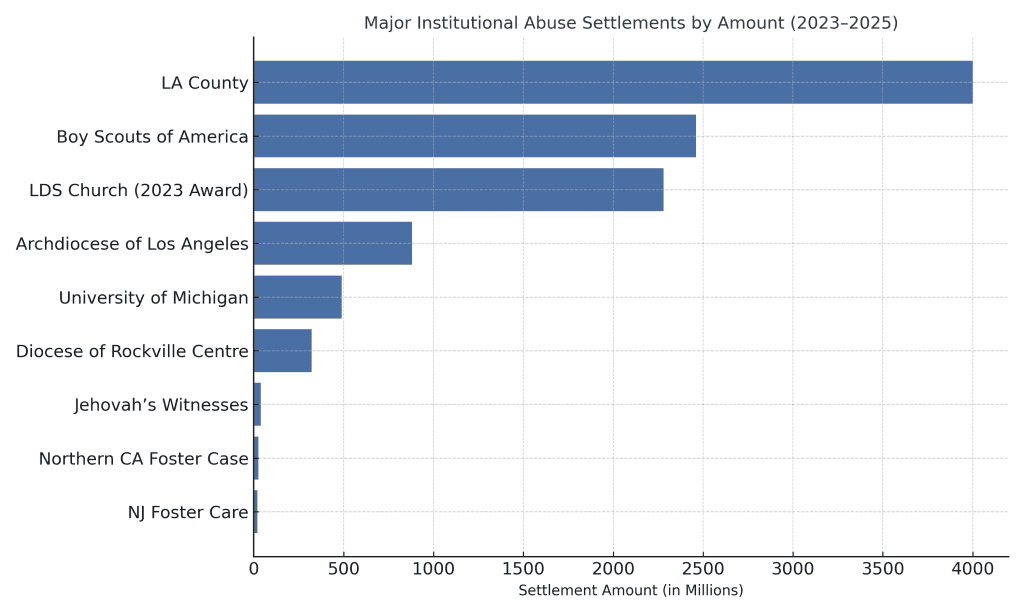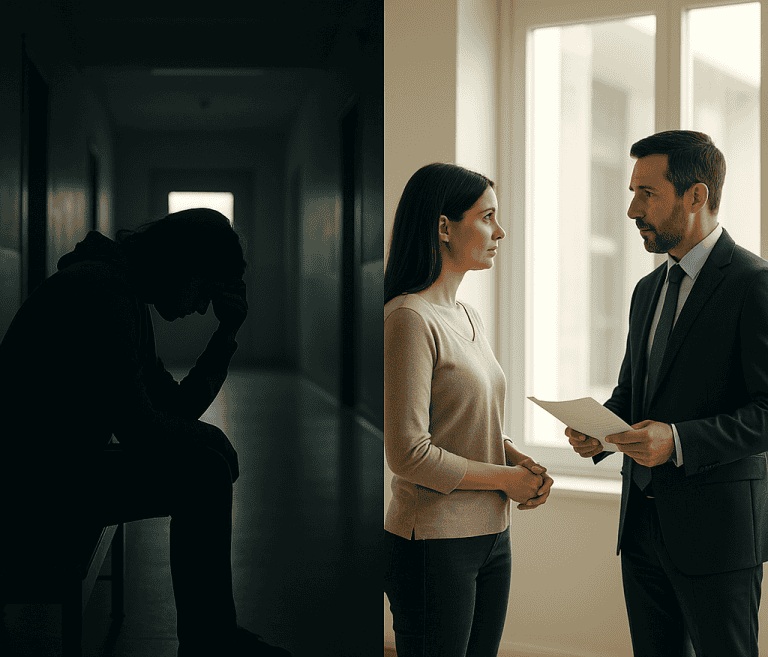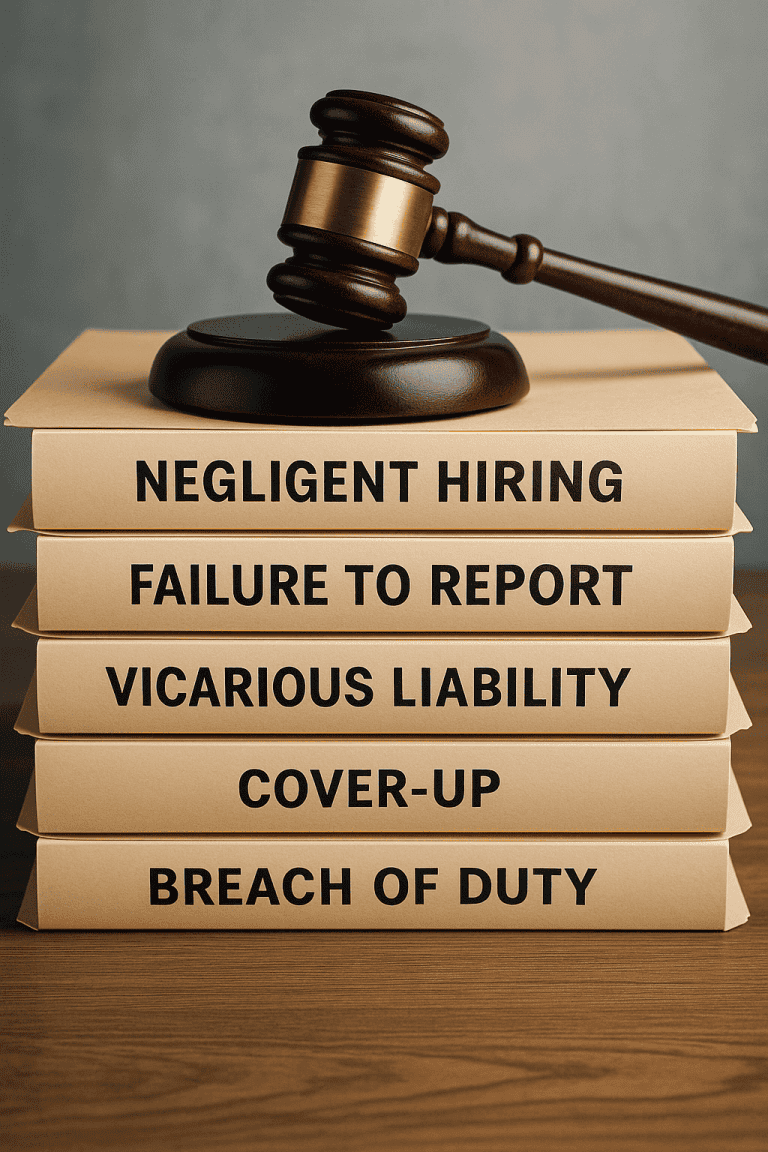Billions in settlements have already been paid or agreed to. Survivors are being believed, and in many instances, significantly compensated. Even if the abuse happened decades ago, legal doors are finally open. But they may not stay open for long.

“Institution.” The very word carries weight—cold, heavy, impersonal. It conjures images of massive systems built not for people, but for process. Not for justice, but for survival of the institution itself.
To be clear, many institutions serve vital roles in society. They shelter the unhoused, educate the next generation, offer spiritual guidance, and care for the vulnerable. At their best, they represent compassion, structure, and service.
But for tens of thousands of people across the United States, these same institutions became the setting for the unthinkable: sexual abuse. Abuse not just by individuals, but enabled, ignored, or covered up by the very systems designed to protect.
Whether in a foster home, church rectory, juvenile detention center, or classroom, survivors have endured trauma made worse by betrayal—betrayal by those in power, and by the institution itself.
This page is for those survivors. It’s here to help you understand your rights, your legal options, and the real path toward healing and justice.
It occurs when a person is sexually abused within or by an organization responsible for their care, supervision, or development.
The abuser may be one or more of the following:
But what defines institutional abuse isn’t just the setting or the act itself; it’s the failure of the system to prevent the abuse, to respond to warning signs, and to hold the abuser accountable.
In many cases, institutions:
These are not isolated incidents. Survivors from across the country, across generations, are coming forward with stories that show disturbing patterns of negligence and even cover-up.
Legal action doesn’t just seek financial compensation. It exposes the systemic failures that made the abuse possible, and it helps ensure it doesn’t happen again.
When survivors come forward, one of the first things attorneys evaluate is who can—and should—be held accountable.
The answer often goes beyond just the individual perpetrator. In cases of institutional sexual abuse, multiple parties may share legal responsibility, especially when the institution knew, or should have known, that abuse was occurring.
Whether it was a teacher, priest, foster parent, staff member, or coach, the perpetrator can and should be held legally responsible for their actions.
Those in management or leadership positions—principals, directors, bishops, administrators—can be held liable if they failed to report, ignored red flags, or protected the abuser.
The organization may face civil liability for:
In some cases, private security firms, boarding schools, or contracted caregivers may also be named in lawsuits if they had a role in enabling the abuse.
Below are the most common settings where institutional abuse has been exposed through lawsuits and survivor testimony. Although these types of institutions where sexual abuse cases have proliferated seem widely different, there is something that connects them: their access to vulnerable individuals and their failure to protect them.
Children placed in foster care are among the most vulnerable. Unfortunately, many have faced abuse by foster parents, caseworkers, or other children in group settings. A 2021 report, “Child Maltreatment,” released by the U.S. Department of Health & Human Services’s Children’s Bureau revealed that 1 in 3 foster children experience some form of abuse (physical, sexual or neglect), often due to underfunded agencies, poor oversight, and misplaced priorities.
—–> $25 Million Foster Care Sexual Abuse Jury Award
In one case from 2023, a Northern California jury awarded $25 million to three siblings sexually abused by a foster parent. The agency, Alternative Family Services, was held responsible for failing to protect them.
—–> $19.5 Million New Jersey Foster Abuse Settlement
More recently, in May 2025, the State of New Jersey agreed to pay $19.5 million to a brother and sister who were sexually abused by their foster father beginning in the late 1960s. The siblings, placed by the state’s Department of Children and Families, endured years of abuse while officials allegedly ignored repeated warnings. The case highlights the long-term institutional failures within the foster care system—and reinforces that justice is still possible, even decades later.
Meant to rehabilitate youth, juvenile detention centers have instead become hotbeds of abuse. Staff-on-youth abuse, lack of reporting, and institutional retaliation have been widespread.
—–>$4 Billion Los Angeles County Settlement
In what is believed to be the largest settlement of its kind, the County of Los Angeles in California agreed to settle more than 6,800 child sexual abuse claims for $4 billion. The claims date back decades, and allegedly occurred in juvenile detention centers and foster care group homes.
In addition, as of 2024, over 667 survivors have filed lawsuits against Illinois juvenile facilities, while Oregon is considering closing one of its largest youth correctional centers after multiple abuse lawsuits came to light.
The Catholic Church is the most well-known example, but it’s far from the only one. Abuse has occurred across denominations, within the LDS (Mormon) Church, Jehovah’s Witnesses, evangelical megachurches, and religious camps, to name a few.
—–> $880 Million LA Archdiocese Settlement
In 2024, Los Angeles was the setting for another massive settlement. This time, the Roman Catholic Archdiocese of Los Angeles agreed to an $880 million settlement to resolve 1,353 child sexual abuse claims.
As for Mormon Church sexual abuse, in a landmark 2023 case, a California jury awarded $2.28 billion to a woman who endured years of sexual abuse by an adult affiliated with the Mormon Church. The lawsuit revealed a deliberate cover-up by LDS Church leaders, who ignored repeated warnings and allowed the abuse to continue unchecked. This case represents one of the largest personal injury verdicts in U.S. history and is part of a growing number of lawsuits facing the LDS Church nationwide.
In these cases, which occur all-too-often, teachers, coaches, and school staff have exploited their authority to abuse students, often with the institution’s knowledge—or silence. Public school districts and elite private academies alike have been implicated.
—–> $490 Million University of Michigan Settlement
Higher educational facilities are most often associated with sexual assault and date rape rather than institutional abuse. Yet several high-profile cases prove that colleges and universities are breeding grounds for sexual abuse. In one of the largest cases, the University of Michigan paid $490 million to survivors of decades-long sexual abuse by an athletic team doctor, with over 1,000 claims resolved.
Youth programs, including church-sponsored camps, scouting groups, and recreational retreats, promote character-building, leadership skill, and foster a sense of community. But when these programs lack proper training, supervision, and abuse prevention protocols, they are dangerous environments for children.
Many of these programs place minors in isolated settings, including overnight cabins, wilderness excursions, or unsupervised dormitories, where abusers can act with little accountability. In too many cases, institutions either failed to act on known risks or actively suppressed reports of abuse to protect their reputation.
—–> $2.4 Billion Boy Scouts of America Settlement
The Boy Scouts of America faced over 82,000 child sexual abuse claims, leading to a $2.46 billion settlement—one of the largest in U.S. history. In February 2024, the U.S. Supreme Court approved it.
Includes hospitals, psychiatric wards, residential facilities for people with disabilities, and long-term care institutions. Abuse in these settings often involves patients who are unable to consent, report abuse, or remove themselves from danger.
—–> $3 Million Western State Hospital (WA) Settlement
In recent years, multiple staff members at Western State Hospital—a state psychiatric facility in Washington State—have been arrested or fired for sexual misconduct against patients. Investigations found repeated failures to monitor staff, report abuse, or enforce safety protocols for vulnerable adults in psychiatric care. The state faced lawsuits and federal sanctions as a result. In one case, the Washington Department of Social and Health Services (DSHS) agreed to a $3 million settlement with a woman who was sexually abused as a minor while residing at the Children’s Study and Treatment Center, the state’s only psychiatric hospital for children.
This unregulated, billion-dollar industry has operated for decades with minimal oversight, despite repeated allegations of sexual abuse, physical assault, isolation, and coercion. Survivors describe being sent to these programs as teens, sometimes by well-meaning parents, yet were ultimately subjected to abuse under the guise of “tough love” or behavioral reform.
Many programs operate in remote areas, cutting teens off from communication, legal advocacy, or outside contact.
—–> Diamond Ranch Academy Utah Forced To Shut Down
In 2023, multiple lawsuits were filed against Diamond Ranch Academy, a well-known residential program, alleging sexual abuse, unsafe conditions, and medical neglect. Former staff members and students have come forward to describe a culture of intimidation, secrecy, and unaccountability.
This is just one of many TTI programs—others have faced media investigations, state-level crackdowns, and calls for federal regulation. Dozens of TTI programs have been forced to permanently close. (For a complete accounting of shuttered TTI programs, the survivor-run, non-profit Unsilenced is dedicated to keeping the TTI industry accountable, and maintains a list.)
These institutions were trusted to care for, teach, guide, or rehabilitate—but many failed.
Survivors have every right to hold them accountable.

For decades, survivors of institutional sexual abuse were told to stay silent or had nowhere to turn. Many feared retaliation, shame, or simply didn’t believe anyone would take them seriously.
And tragically, for many years, the law was not on their side. But that’s no longer the case.
Across the U.S., a powerful shift is happening. Survivors are stepping forward, and lawmakers, courts, and communities are finally listening.
If you’re a survivor, here’s why now is the time to act:
In response to pressure from survivors and advocacy groups, many states have passed “lookback window” laws or eliminated time limits entirely, allowing older cases to be filed in civil court.
These legal reforms mean you may still have a right to file, even if your case was once considered “too old.”
Recent laws such as the Adult Survivors Act (NY) and California’s AB 218 were specifically designed to give survivors of institutional abuse another chance to seek justice.
These laws acknowledge what trauma experts and survivors have long known: it can take years, even decades, to process abuse and feel safe enough to speak out.
In some cases, such as the Boy Scouts of America, Catholic dioceses, and other institutions facing mass claims, bankruptcy settlements have established victim compensation funds.
From major investigative reports to documentaries and public apologies, the national conversation around institutional abuse has changed. Survivors today are:
You are no longer alone—and your case is no longer invisible.

When survivors of institutional sexual abuse take legal action, their cases are not only built on personal testimony. They’re also backed by powerful legal principles that recognize the responsibility institutions have to protect those in their care.
When an institution fails to properly vet, monitor, or discipline employees or volunteers who go on to commit abuse.
A legal principle that holds institutions responsible for the actions of their staff or representatives acting within the scope of their duties.
Many states have mandatory reporting laws. If an institution failed to alert authorities to known or suspected abuse, they can be held liable.
Especially relevant in religious, healthcare, or custodial settings, where institutions have a heightened duty of care to vulnerable individuals.
In cases where institutions deliberately concealed abuse, moved abusers to new locations, or destroyed evidence.
The bottom line is that these legal theories make it possible to hold not just individual perpetrators accountable, but also the systems and institutions that enabled the abuse.

Thanks to legal reform and growing public support, survivors now have multiple pathways to pursue justice — inside and outside the courtroom.
Survivors can bring a civil case against:
A civil lawsuit can result in compensation for:
Even if the abuse happened long ago, statute-of-limitations reform in many states now allows these lawsuits to move forward.
Get a free case review by filling out a very brief form.
Large institutions that have filed for bankruptcy—such as the Boy Scouts of America and multiple Catholic dioceses—have established court-ordered trust funds for survivors.
Deadlines are strict. If missed, survivors may lose the right to seek compensation through the fund.
Some states (such as California) have public victim compensation funds. While they typically offer smaller payouts, they may help with therapy costs, relocation, or lost wages.
A civil claim does not require criminal charges to be filed. However, survivors may still choose to report the abuse, especially in recent cases. Criminal proceedings are separate from civil ones and have a higher burden of proof.
Many states allow survivors to:
Experienced attorneys can protect your identity throughout the legal process.
These legal theories provide a gameplan and blueprint for survivors to hold institutions accountable for their role in enabling or failing to prevent abuse. Of course, it’s easier to experience justice and win compensation if you have the help of a legal advocate fighting for your rights.
If you or someone you know has experienced institutional abuse, consult with an experienced attorney to explore your legal options.
SurvivorsRights.com may help connect you with an attorney in your area who specializes in institutional sexual abuse cases.
See if you qualify to file a lawsuit by answering a few questions below.
…And you don’t have to decide everything today.
Speaking with an attorney who specializes in institutional abuse cases can help you understand your rights, and take the first step toward healing and accountability.
But these windows for the statutes of limitation won’t stay open forever.
Many survivors don’t take action. They choose to suffer in silence.
However, it doesn’t have to be this way…
If you or someone you love experienced abuse, you can begin the healing process by just filling out a few questions below.
Institutional sexual abuse occurs when someone is sexually abused while under the care, supervision, or influence of an organization—such as a school, church, youth camp, detention center, foster home, or treatment program. It includes abuse by staff, volunteers, religious leaders, or anyone operating with authority under that institution.
Yes. Many states have passed laws that extend or eliminate the statute of limitations for sexual abuse claims. Even if you were told in the past that it was too late, you may now have a valid case. It’s important to speak with an attorney to determine your eligibility based on where and when the abuse occurred.
In addition to the individual perpetrator, institutions may be held liable if they failed to prevent the abuse, ignored warning signs, or covered it up. This includes churches, schools, government agencies, nonprofits, foster care agencies, and more.
Not necessarily. Many institutional abuse cases settle outside of court, and in many jurisdictions, survivors are allowed to file anonymously (e.g., as “Jane Doe” or “John Doe”). Your attorney can request sealed records and take steps to protect your privacy throughout the process.
Survivors may receive compensation for:
The exact amount depends on the specifics of your case and the institution involved.
Nothing upfront. At SurvivorsRights.com, we may help connect you with trauma-informed attorneys who offer free, confidential consultations. If you decide to pursue a case, most work on a contingency fee basis—meaning they only get paid if you win.
That’s okay. Just reaching out to learn your options is a powerful first step. You don’t have to make a decision today. We’re here to answer your questions without pressure, judgment, or obligation.
You’ve read the truth: survivors of institutional sexual abuse are securing major legal victories. From million- and even billion-dollar settlements to long-overdue accountability, justice for survivors is increasingly becoming common-place.
If you were abused in a foster home, school, religious institution, juvenile detention center, or treatment facility, you may be eligible for financial compensation—even if the abuse happened decades ago.
SurvivorsRights.com may help connect you with a trauma-informed legal team that understands what you’ve been through—and knows how to fight for the justice you deserve.
✅ 100% Confidential
✅ No pressure, no obligation
✅ No fees unless you win
✅ Compassionate attorneys with institutional abuse experience
Fill out the form below to start your confidential case review.
Speaking with an attorney who specializes in institutional abuse cases can help you understand your rights, and take the first step toward healing and accountability.
But these windows for the statutes of limitation won’t stay open forever.
Many survivors don’t take action. They choose to suffer in silence.
However, it doesn’t have to be this way…
Even if the abuse occurred decades ago, compensation may still be available for your suffering. Fill out the brief form below to get a free case review.